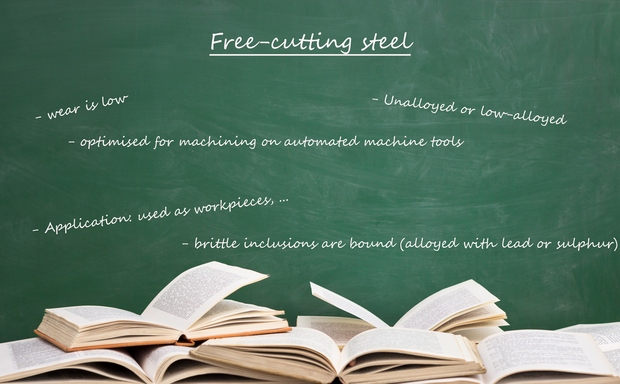Properties of free-cutting steel
Free-cutting steel, also called bright steel, is a steel that has been optimised for machining on automated machine tools.
It can be unalloyed or low-alloyed and has an increased content of lead, sulphur or phosphorus.
Free-cutting steel is a hard, cold and smooth material that has different shades of grey.
If it is alloyed with lead or sulphur, brittle inclusions are bound. This makes for better machinability,
as the point at which the chip breaks is shorter. Free-cutting steel is not weldable due to
the high lead and sulphur content. However, it can have good machinability with good chip breaking.
In addition, the surface quality of free-cutting steels is good and wear is low. Wear, also called abrasion,
is the loss of mass of a surface. This is caused by abrasive, scratching, thermal or other stresses.
To obtain free-cutting steel, steel must first be extracted from iron ore. To do this, iron ore and coke are put into a blast furnace, where hot air is blown in. Iron and carbon dioxide are produced from a chemical reaction that removes the oxygen from the ore. The iron melts in the blast furnace and a slag forms on top, which is separated from the liquid pig iron.
The pig iron can then be further processed in the following steps.
In the next step, the Frisch reaction, oxygen is blown into pig iron, forming liquid iron oxide. To obtain free-cutting steel, steel must first be extracted from iron ore. To do this, iron ore and coke are put into a blast furnace, where hot air is blown in. Iron and carbon dioxide are produced from a chemical reaction that removes the oxygen from the ore. The iron melts in the blast furnace and a slag forms on top, which is separated from the liquid pig iron. The pig iron can then be further processed in the following steps. In the next step, the "Frisch"-reaction, oxygen is blown into pig iron, forming liquid iron oxide. Free-cutting steel is used a lot in the series production of automatic lathes, milling machines or boring mills.
Do you want to have a milled or turned part made from free-cutting steel?
Or are you interested in having your desired component milled or turned with the help of contract manufacturing?
Submit your enquiry quickly and easily and we will get back to you with a quote in line with the market.
We look forward to hearing from you.


